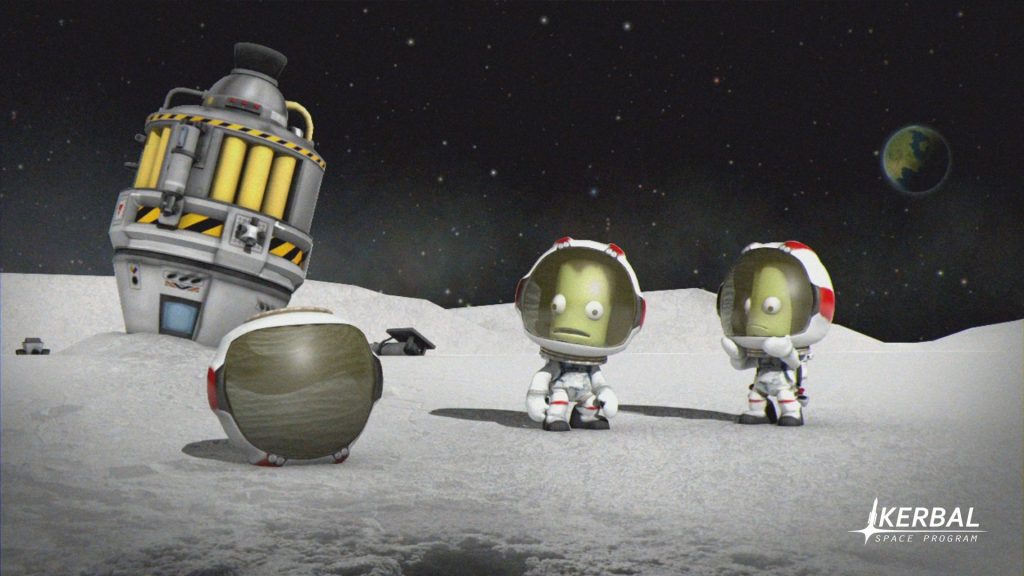Kerbal Space Program is available on Steam, Xbox One, and PS4. We’re reviewing it on Xbox One!
I don’t have a very logical brain.
When it comes to things like statistics, charts and work orders, my head just kind of freezes up. My brain works best when I’m reading, or reacting – the finger that pulls the trigger as opposed to the mechanism firing the bullet. Hell, it took me about six hours to just about start getting my head around some of of RimWorld’s more intricate systems, let alone something that gets as close to actual rocket science as videogames have ever gotten.
Kerbal Space Program is not friendly to people with my mindset. The little picture people, more gratified by the explosion than what makes it happen in the first place. Don’t be deceived by the cutesy Kerbals – a visual mix between Ubisoft’s demented Rabbids and those despicable yellow things I don’t want to name here – this is a deep sim game that doesn’t pull any punches.
The tutorials, thankfully, are comprehensive, covering everything from building your first flight-ready rocket to the finer points of interstellar travel. It can be a lot to take in, but the training is provided in convenient chunks that lay out a breadcrumb trail to eventual success. Conquer the first few training exercises and you might feel confident enough to strike out on your own, but one failure and a handful of obliterated Kerbals smashed against the planet’s surface and you’ll quickly be back to pick up some new knowledge before you try again.

This all looks very serious now but rest assured, dick rockets definitely exist. Just don’t google the phrase ‘dick rockets’, please.
Coming in fresh, you will fail, unless you’re a real-life rocket scientist or dubious hobbyist. There’s so much to take in, so many different interlocking systems that all contribute to whether your flight ends in space-bound glory or fatal explosions. The array of parts available to build different spacecraft is vast, making your first few voyages seem like a gargantuan task. When it all starts to come together and you’re riding into orbit on a rocket of your own making, that first glorious break of the horizon as you finish a looping arc into orbit and beyond is nothing short of thrilling.
The voyage doesn’t stop at launch and re-entry, though. Get yourself into space and there’s a bevy of different activities to pursue – spacewalking, satellite positioning, research experiments. Kerbal Space Program is a toy box filled with jet fuel, supernovas and mind-shattering mathematics. Once you’ve got even the slightest grasp on the basics, it opens up. Frustration turns to elation, and every failure just propels you to greater heights.
Landing on the moon is just the tip of the… moonberg? There’s not a lot of limits to how far you can go.
The game’s biggest fault – and it’s not even a real fault – is that it just doesn’t translate to console very well at all. There’s a ton of menus and tools to navigate that just aren’t intuitive with a controller, resulting in a lot of awkward shortcuts that don’t mesh well with the hard science that forms KSP’s molten core. It’s great that consoles are starting to see the unexpected genius ofindie hits like this, but until they embrace mouse and keyboard support, titles with such a meaty amount of input like this will struggle to come across properly.
Console players already unsure about the amount of actual science and various laws of acceleration and aerodynamics will definitely be put off by the variety of button combinations KSP on Xbox uses to make up for the limited controller input. Having played the game on both formats I can tell you without a shadow of a doubt it’s infinitely easier to navigate, but that probably doesn’t come as much of a surprise.
What’s really impressive is how Squad have brought all these complex physics and scientific basis together into a space-flight simulator that discards all the stuffiness and massive manuals that usually come packed with titles in the genre. It’s lighthearted, carefree, often hilariously absurd, and throughout all of that a rich, layered simulation. You can spend hours launching test flights, playing tutorials, and fiddling with precision settings until you have your flights down to an art.
Or you can strap a massive jet engine to a tiny pod and giggle like a lunatic as it burns up and explodes during a ludicrously fast re-entry. Any way you want to play it, Kerbal Space Program doesn’t just give you the freedom – it actively encourages it.

Best not get attached to any of your Kerbals.
The Kerbals deliver a massive, comprehensive experience. Alongside a campaign that has you building the space program from the ground up, researching new parts and undertaking missions, there’s a load of pre-built ships in all sorts of crazy configurations you can launch (or rather, try to launch) for some instant gratification. There’s a ton of scenarios set up to test your skills and, of course, a sandbox mode that lets you strap a bunch of engines to a metal tube and see how far it gets (or create the obligatory dick-rockets).
The best thing is the game is still expanding and improving despite already providing a huge amount of content. So whether you want an authentic space-exploration simulator or the ability to goof around with high-powered technology whilst blowing up innocent little Kerbals to satiate your twisted god complex, this one-of-a-kind game has the goods.
Kerbal Space Program TL;DR:
- A brilliant simulation packing hard science and physics into something palatable for everyone.
- You can play it straight, or you can be silly – there’s no wrong way to launch rockets in this space program.
- Console versions struggle with limited controls.
- Don’t google dick rockets.
95%
For even more gaqme reviews, click right HERE.